Although there are those who say that wood should be used uncolored, its natural color is its charmIt's most often found in color, from natural shades of walnut or pine to the most unusual colors. It is also preferred this way because color brings out its natural design much better. But staining wood is not a simple operation. Wood is a non-homogeneous and anisotropic material with different properties from species to species, within species and even within the same piece of wood depending on the grain orientation. This makes achieving a uniform, stain-free coloration a rather difficult task. But not impossible.
Why stains appear when staining
The main cause of stains is different color absorption in the wood. It happens because of the quality of the wood or the way it is processed before staining. If we are talking about the quality of the wood we are talking about its density, how easily it absorbs the staining solution, the resin or tannin content or growth defects (knots, twisted fiber). I mean, a wood like poplar, fast-growing and very lank, it absorbs color quickly and differently and stains can appear very easily. Oak but it's dense and tougher, which makes for even absorption and stain-free coloring.
Related to machining is how the wood is cut and sanded. Clean cuts, free of nicks and gouges, made with quality, sharp tools, make for more uniform absorption. Sanding is one of the most important processes for the final appearance of the product. The uniform coloring, the adhesion of the varnish, the nice feel of the film all depend on how much attention has been given to sanding. I consider sanding so important for a quality end product that I have put it at the top of my recommendations for stain-free wood staining.

photo source: homesteadfinishingproducts.com
1. Sanding the wood before staining is very important for stain-free staining
Sanding is used to smooth out those fiber ends that result from cutting wood. It is through these fibers that food enters the tree before it is cut. This is why the color penetration here is natural and if left unchecked can lead to staining.
Sanding is done first with sandpaper or coarse sanding sponges - grit size 80-100. Then move to finer grits to give that nice touch. On hardwood - oak, frasin, fag - finer grain is considered 150, sufficient to achieve a quality surface. If the wood is soft, loose and uneven - poplar, lime, arineven molid - 180 or 220 grit is needed to "tame" the dyed fiber and get the most uniform color.
Sanding also removes any glue or grease stains (greasy fingerprints from food or products used in production) or fine scratches. If these areas are not sanded, stains will appear after staining. On wood they are not visible before staining. However, sanding removes them and thus eliminates the risk of staining.
Don't ignore this step if you want a quality product. The more time you spend at this stage, the better the coloring and later the finishing. More information on white sanding can also be found at here.
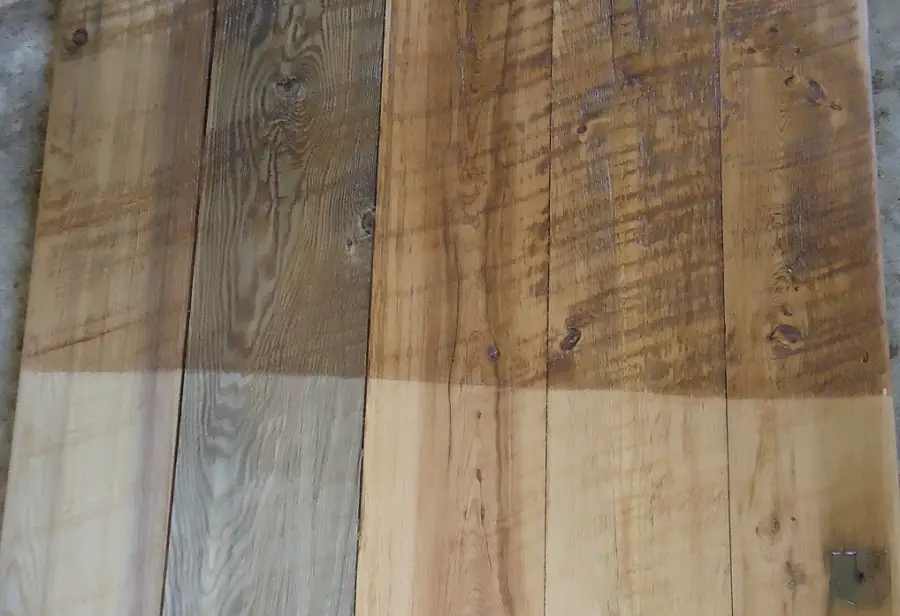
photo source: circlerockinc.com
2. Choose the coloring solution according to the wood essence
It may seem strange, but not all wood species behave the same when treated with a particular type of staining solution. For example, oak and beech are both hard, high-density species. However when treated with a staining solution made from pitch and white spirit (P43 - famous decades ago) behave totally differently. While oak stains beautifully and evenly, wood on beech, no matter how well sanded, will be full of stains. That's why a minimum of documentation on wood staining behavior can save you a lot of trouble.
Coloring solutions (stains) can be water-based or solvent-based, with or without added resin, made of soluble dyes or pigments. Although, generally speaking, each has its own type of behavior (pigments even out, colorants bring out the natural design, etc.) interaction with wood can produce surprises. That's because wood contains tannins, resins, dyes and many salts that can influence coloration and absorption in wood. This is why in factories, tests are always carried out on the wood that will be used in production with the chosen wood stain. In this way, the behavior of the wood can be seen and the wood seasoning can be adjusted according to the needs.
A few tips on staining wood:
- Water-based stains penetrate deeper into the wood, making staining more likely. But the colors are more vivid and the natural design better brought out;
- Solvent-based baths behave differently depending on the solvent mixture used. They can be more easily juggled by making them dry faster or slower or penetrate more or less into the wood. Everything is adjusted by varying the proportion of solvents in the thinner mixture;
- a stain made with acetone is uniform, staining is only done on the surface of the wood (acetone evaporates very quickly);
- Acetone and ethyl alcohol (technical alcohol) are miscible with water. You can speed up the drying of water-based baths by replacing some of the dilution water with acetone or alcohol.
Whatever the type of stain, always check on a small area the compatibility with the wood used. You will only be able to tell how it looks once the stain is completely dry and coated with varnish (or primer). This highlights even the least visible defects.
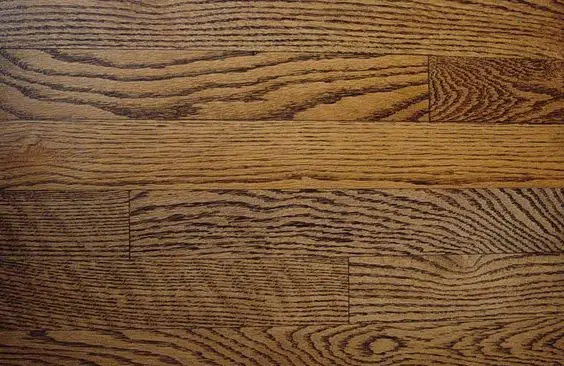
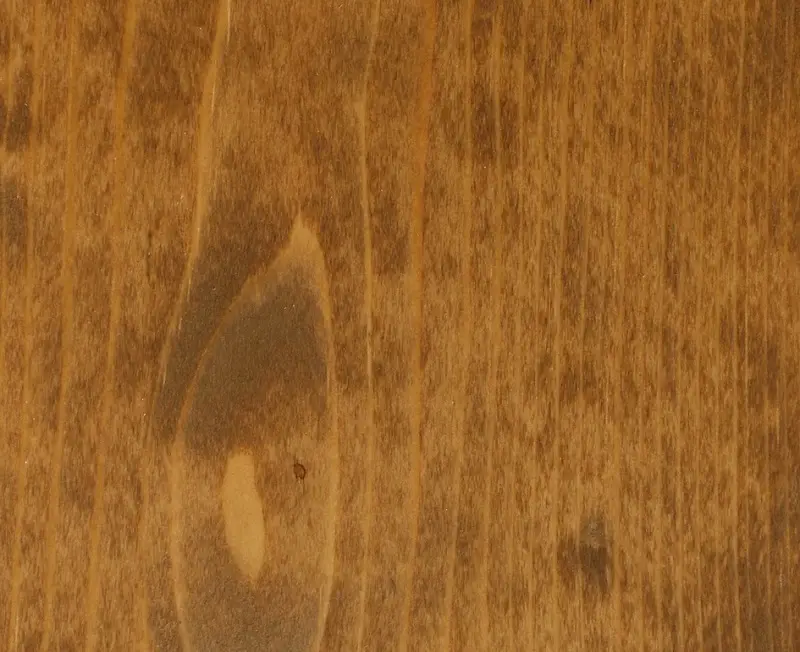
3. Choose an application method that allows more control over the amount applied
Stains occur mainly as a result of the coloring solution absorbing into the wood. If in one place the wood can absorb more color in that place it will stain. If the brush loaded with color is placed directly on the wood without reducing the amount by wiping it from the edge of the container, a dark stain will appear there. Therefore, controlling the amount applied can reduce the risk of staining.
In factories it is best to control the coloring when the application is done with a spray gun. Spraying It starts outside the coloring surface and ends outside it, so as not to deposit more or less color. You can adjust the amount coming out of the spray gun so that a certain amount/m² is applied. The coloration will be more uniform and stains will only appear if the wood is not well prepared in white.
Trafaletus also allows a fairly good control of the amount applied. The choice of the type of material covering the drum is important. In the case of sponges, they can be of different qualities. The smaller the amount they embed or the more controlled the amount released, the more uniform the coloration will be.
When staining with brush, cloth or sponge care must be taken that they are not placed loaded with solution on the wood because a stain will appear there. Always squeeze them first. Put the whole of the wick into the colored bowl and then squeeze it out. Don't soak it only partially, because over time it will accumulate more and more color and transfer it to the wood, becoming lighter at the beginning and darker at the end.
Whatever the method, do not partially overlap the color layers as a stain will appear there. In other words, do not pass twice with the brush, charcoal, brush, trafalquet, pistol over a portion where the wood has already absorbed color and has become a little bit shiny. There the wood will absorb twice as much and that portion will be darker.
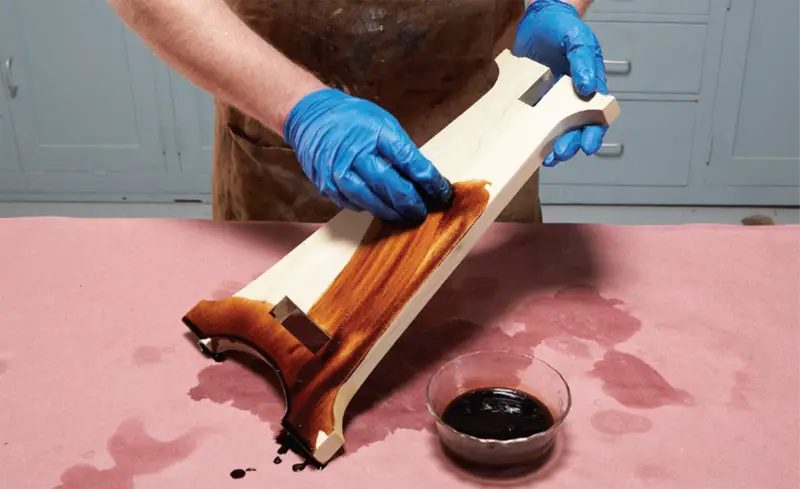
4. Blocking deep absorption when wood is soft and absorbs unevenly
There are situations where no matter how careful we are with the application, no matter how well we control the amount applied, stains still appear because the wood is too soft, loose and uneven. In this case the solution is to keep the color as close to the surface as possible so that the wood has as little influence as possible.
We saw above that one way to do this is use of rapidly volatile solvent-based baths, i.e. acetone. When applied with a spray gun, the stain is almost dry on the surface of the wood and the coloration is very uniform. The disadvantage is that the natural design of the wood is less emphasized and, above all, the working environment becomes very difficult to withstand because of the solvent.
Another method is "thickening" the bath so it's harder to absorb. It can be done by adding resin to the bath. A simple method is to add nitro varnish to simple solvent-based varnishes or waterborne varnish to water-based ones. Compatibility should be checked beforehand by mixing small quantities. Do not add a very large amount because it turns into a colored varnish which can give a plastic look to the wood.
Tot de primer we can use to create a barrier in the way of the bathtub. The primer (varnish) to be used should be diluted 50, even 100% and applied to the wood before staining. It must not film. After drying sand the wood again and apply the stain. Absorption will be less and the stain will be more even and stain free, but lighter in color. For a darker stain use a more concentrated stain or apply 2 coats of color.
Areas where there are fiber ends and absorption is high (milling or turning) can be blocked with a diluted solution of aracet (aracite in water). The solution will be absorbed, harden and lock the fiber. It must not be thick and filmy. After drying and before applying the wood stain, sand the wood white.
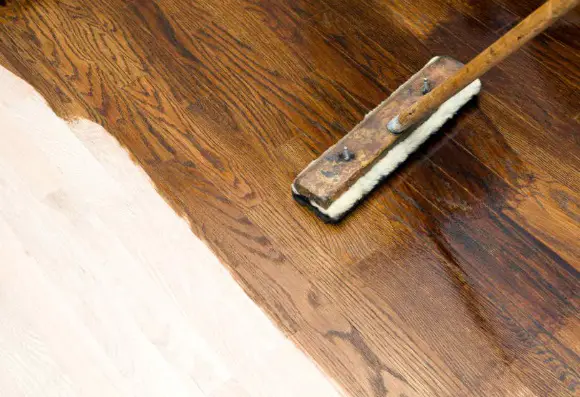
5. Use standardizing solutions
If, however, the coloring is uneven and spots appear on the surface of the wood, but not very noticeable, the defect can be reduced by using color-uniforming methods. This method is very common in furniture factories, but it is not complicated and can be used in smaller or even diy projects.
Uniformization can be done with a staining solution similar to that with which the wood has been stained, but more diluted, which is applied in a very thin layer on the stained surface or after the first coat of primer. The solution should be solvent based, acetone based is best. The layer must be very thin so as not to change the color (the levelling will slightly darken the initial color) and not to affect the adhesion of subsequent coats (if applied over the primer). The layer over which the levelling compound is applied must not be sanded so as not to alter the color.
Another way to even is by lightly staining the first coat of primer. Again, the addition of color should be small so as not to change the color too much and not give a plastic look to the finish. To be able to be added to the primer, the color must be of the same nature. That is to say, in solvent-based primer, you add a solvent-based putty and in waterborne putty a water-based putty. Be careful, not all are compatible even if they are of the same nature. That is why a test must be done beforehand.
Wood staining is an important step and if it is not done well the whole project can be missed. We have always said that wood is very important, but what sells furniture (or other wooden objects) is the design and finish. Furniture made of the best wood, even if it has an attractive design will not be bought if it is full of stains.
On the other hand, we have to learn that wood is a special material with a personality that we cannot always tame. But that is precisely its charm. A wood that absorbs differently and has a final appearance that is not very uniform can be much more appreciated and more desirable than one whose uniformity can be considered monotonous. I am not talking here about ugly stains, but about the appearance of wood that absorbs more on one side and less on the other. It is its signature that we must learn to respect.
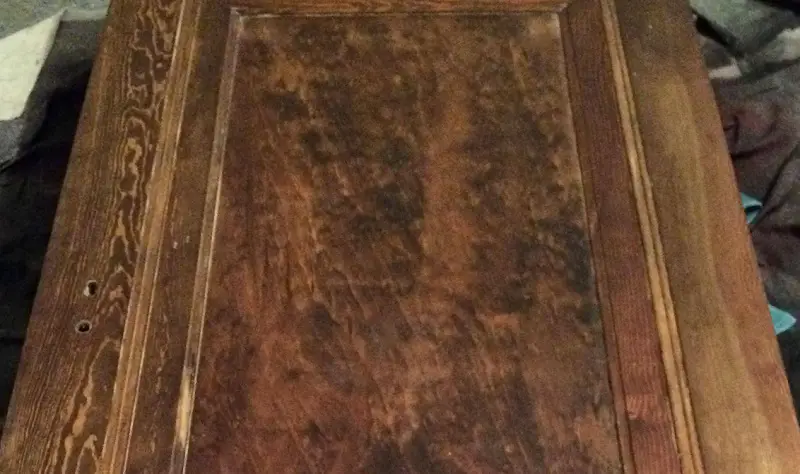
photo source: diy,stackexchange.com



































Hello
Nice article, I want to ask if I can even out with the diluted primer method 2 oak veneered panels one being slightly reddish. Over them subsequently apply bait based on water and varnish.
Thank you.
Good evening!
To even it out you should make a larger-bodied bath by adding water-based primer. Then try smoothing by applying the material with a spray gun. You should check the compatibility between the 2 products beforehand. No film should form so that the wood can still fix the filler. Before applying the filler let it dry thoroughly and sand lightly with 150 or 180 grit paper.
All the best!
Don't forget to subscribe to the printed Wood Magazine! For only 58 lei/year you can find out news in the field, discover craft ideas or trade secrets. We remind you that the content in the printed magazine is different from the one on the website. Details in the link below.
Thank you!
https://revistadinlemn.ro/product/abonament-revista-din-lemn/
Hello and Happy Birthday!
I would need some advice on how to turn an old oak parquet floor, which I am going to scrape and possibly strip, into a white or grey Norwegian oak floor. I can't find any wood stain or varnish in this shade and it is not clear to me whether to first apply a wood stain in this shade and then a matt water-based varnish for protection or whether it can all be done with one product.
Thanks in advance for the advice!
Hello!
We wish you a Happy New Year, with health and joy.
There is also the version with varnish and colored varnish. For the first variant you need a gray gait to imitate the wood "aged" by time. A non-yellowing varnish is applied over it so as not to change its effect (acrylic varnish on solvent or waterborne varnish). There is also the possibility of applying a colored varnish, but there is a risk that the coloring cannot be controlled very well. If colored coats are superimposed on certain areas, a darker color and a better coverage of the wood will appear, losing the desired effect.
Such materials can be found at specialised wood products distributors. They distribute products specially made for such special finishes. Look for distributors of professional products in your city (ICA-Lomilux, Milesi, Sirca, Bona, Sayerlack, Renner are only a few of these brands).
All the best!
Hello,
I have a question and that is what can you mix the thinner with to make a bait?
For a water-based bath it is easier, you can use washable paint dyes, which are not compatible with thinner/white spirit.
I look forward to hearing from you.
Thank you
Hello!
There are mineral or synthetic dyes in the form of powders soluble in organic solvents or oils. You should be able to find them in paint shops. In the past they were easy to find because they were made in Codlea. It was more complicated to obtain the bath because the powder was easily spread and was also very concentrated. But very beautiful dyes were obtained.
But now there are colour concentrates where the dye is already dissolved in a solvent, making it much easier to use. The solution can also be diluted several times with thinner to obtain the desired shade. These solutions are available from wood varnish and paint distributors or DIY stores.
Some dyes used for washables are also soluble in organic solvents. You can try dissolving them in alcohol or acetone.
With oil it is more complicated, but you can use mineral pigments. They don't dissolve, but can mix very well with oil. Start with a small amount of oil to which you add the pigment and rub the mixture very well until the lumps disappear. This is best done on a metal table, stirring with a spatula or a wide-bladed knife or in a garlic grinder. Once you have obtained a very homogeneous paste dilute with oil until you reach the desired intensity.
Good luck!
Hello, I would like to refurbish the house elm which is made of fir wood, which 13 years ago was given with linseed oil (I think) and a water based bath. Because of the weather conditions and the way of application at that time it is f. stained . What could I apply to it so that these stains are no longer visible and also protect it for longer ?
Thank you
Hello!
You can apply a coloured varnish. If the oil is completely gone, you can apply a water-based stain. If there are still traces of oil you will have to apply an oil-based varnish because the water-based varnish will not adhere. The varnish will fade the colour differences and protect the wood. If you apply 2 or 3 coats the colour will darken, it will be less transparent, but will protect the wood better.
All the best!
Hello. How do I remove paint from a painted door by brushing with caustic soda solution. I am interested in how to prepare the caustic soda solution and how to apply it, in how many layers.
Hello.
Soda is used to remove old alkyd or linseed oil based paint. Dissolve 3 tablespoons of soda in 1 l of warm water and apply the solution with a sponge or brush on the painted surface. Let it work for 10-15 minutes and then wash off with excess water. If the paint is alkyd or oil-based, it will turn into a brownish liquid. After washing, neutralise the surface with vinegar before applying another finish. Allow to dry before applying another coat.
Caution: wood may darken after soda treatment. Check first in a more hidden place. Use protective gloves when applying soda.
All the best!
I have a lacquered pine kitchen cabinet that has changed color to a reddish color. I would like to refurbish it. What do you recommend I do?
Hello!
Softwoods (fir, spruce, pine) have this tendency to darken in colour over time, turning dark reddish yellow. My advice is to stain it. You will need to wash it with water and dishwashing detergent, wipe it well and then sand it lightly with an abrasive sponge on 280-320 grit sandpaper (found in DIY stores). Then apply 2-3 coats of nitrocellulose paint (solvent-based) or water-based paint with a brush. You can also find these types of paint in DIY stores.
All the best!
Hello! I want to refurbish the old parquet and I would like to know the correct order of the finishing steps, provided that I would also like to stain it. I understand that you can stain directly with bait, you can add bait in primer or varnish and the process or number of coats starts to vary in each situation. What variation would you recommend as the least complicated as I am pressed for time.
Hello!
After sanding and sanding, stain (stain) to the desired colour and then apply 2-3 coats of floor varnish, preferably water-based, with drying and sanding between coats. Sanding between coats is necessary for adhesion between coats of varnish and for a smooth and pleasant to the touch surface. The varnish is applied with a trowel.
As you mentioned, staining can also be done by putting baths in the varnish. However, I do not recommend this method, especially for beginners, as there is a risk of an uneven look if the varnish layer is not even or if it runs back in places. Unevenness can also occur with direct grouting, which is why it is best to use parquet stains that have a longer drying time and allow the parquet to even out the colour.
In conclusion, first apply the bath, then 2-3 coats of floor varnish.
Below are links to articles you may find useful.
All the best!
https://revistadinlemn.ro/2018/02/13/raschetare-parchet-etape-si-realizare-intretinerea-parchetului/
https://revistadinlemn.ro/2019/05/16/5-sfaturi-de-finisare-pentru-a-evita-obtinerea-suprafetelor-aspre-si-rugoase/
https://revistadinlemn.ro/2021/03/18/am-colorat-parchetul-cu-lazura-iar-lacul-aplicat-deasupra-s-a-exfoliat-unde-am-gresit-si-cum-pot-remedia/